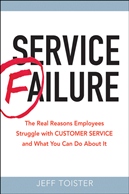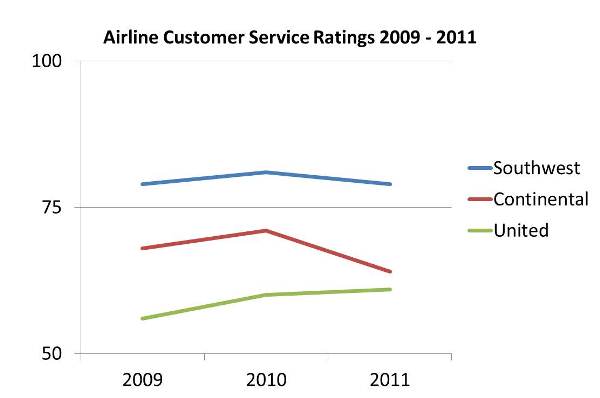Five reasons why ratings are down at Southwest Airlines
 Jeff Toister
Jeff Toister  Thursday, June 21, 2012 at 9:45AM |
Thursday, June 21, 2012 at 9:45AM | The American Customer Service Index released it's annual airline service ratings this week and the results for Southwest Airlines underscore what many travelers know already: the legendary customer service at Southwest is on the decline. The airline relinquished their long-held position at the top to Jet Blue after suffering a 4.9% drop in their satisfaction ratings, although their 77% rating still puts them well ahead of traditional legacy carriers US Airways, Delta, American, and United. (See the results here.)
What's behind the decrease in service quality? Here are my top five reasons:
1. The Merger
The airline's merger with Air-Tran is clearly pulling executives' attention away from other issues like service. While this is normal during an airline merger (see my post on the United-Contintental merger), it's unsettling to see it happening at Southwest. There's a great break down on the challenges Southwest is facing as a result of the Air-Tran merger on the InvestorPlace.com website (see their explanation).
2. Seating
It's getting harder to get a good seat on a Southwest flight. Their open seating system, unaffectionately referred to as the "cattle call," has long been a disadvantage for Southwest Airlines. However, the process is starting to get worse as their are more options for people to pay a fee to get a better spot in line. A-list frequent flyers, Business Select passengers, and people purchasing the EarlyBird check-in option all get on before everyone else who either doesn't fly Southwest often enough or isn't willing to pay an extra fee. A recent J.D. Power survey found that fees for checked baggage leads to significantly lower customer satisfaction (see their study here) and Southwest has so far managed to steer clear of this practice, but charging fees to get on the plane sooner is likely to have a similar effect.
3. Cleanliness
Southwest's planes seem to be getting dirtier. They pride themselves in turning around a plane between flights faster than their competitors which ultimately means they have to invest in fewer planes. However, this efficiency is starting to come at a price. The lavatories are often disgusting, food wrappers are left in the pockets behind the seats, and crumbs are all over the cabin floor.
4. Rapid Rewards
The changes Southwest made to their Rapid Rewards frequently flyer program are, uh, unrewarding. In his book, The Amazement Revolution, Shep Hyken talks about the power of making customers feel like members. The old Rapid Rewards program accomplished this nicely. You received a free round trip ticket after flying eight round trips (or sixteen one-way flights) and they even tossed in some drink coupons. It was simple to understand and chart your way towards your next free trip. The new program is based on points that somehow correspond with the fares you pay and can be redeemed for... Well, I'm not really sure how it works. I stopped caring once I had to get out my calculator to figure out if I was getting close to a free flight. I'm sure the new program makes perfect sense to Southwest's accountants, but it fails to create the same emotional connections with customers that their old program did.
5. Customer Service
A little redundant, I know, but hear me out. I sent all of this feedback in an email to Southwest Airlines in keeping with my personal policy of sharing this sort of thing with companies before I write about it on my blog. Even the process of providing feedback was a service failure. I had to fill out thirteen required fields on their form just to submit my message and then I was directed to a screen that informed me it would take approximately five days for them to respond. Yikes! As you may know from my recent email response time survey (read that here), people generally expect a response within one business day. Five days is simply too long and after waiting three days without a response I've decided to go ahead with this post.
I'm a huge fan of Southwest Airlines and I hope they can turn things around. However, until they take steps to address some of these issues I know I'll be choosing them less frequently.
 Jeff Toister
Jeff Toister
I received a response from a customer service rep at Southwest Airlines shortly after I wrote this post and three days after I emailed their customer service team. It was a thorough, albeit lengthy email that was mostly a canned message with a few personal notes. And, as a nice gesture, I was offered a $100 voucher to use on my next flight. That was very kind and definitely unexpected.
Here's a summary of the response I received:
- Open seating is part has made them successful and customers are overwhelmingly in favor of it. (No mention of my concern about charging fees to board faster.)
- The new Rapid Rewards program better reflects their evolution from a regional, shorthaul carrier to an airline that flies longer routes. The response also stressed the additional benefits of the new program, such as the ability to redeem points for any seat on any flight or using points to book hotels and rental cars.
- The lack of cleanliness on their planes is an unfortunate by-product of their quick turnarounds.





